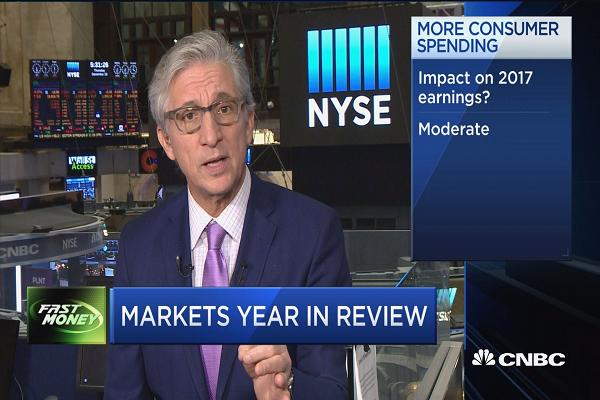I noted yesterday that the market debate was between “pragmatists” and “optimists” over two 2017 issues:
1) Will consumer confidence remain high and, specifically, will the Trump rally translate into more consumer spending?
2) How much will expectations for tax cuts and fiscal stimulus impact earnings in 2017 and 2018?
Here’s my concern: Investors seem wildly optimistic. Consumer sentiment and business sentiment surveys have all popped after the election. The recent National Federation of Independent Business survey, for example, found dramatically different attitudes among small business owners before and after the election.
Investors are not just expecting a rally — we’ve already had that — they are expecting some kind of global reflation to occur.
I’m wondering where it will come from. Let’s look at the evidence presented so far.
1) Consumer spending will increase. Will it? We could get a cut in the personal income tax, or consumers may simply feel better and begin spending more of their savings.
Let’s put aside the personal income tax cut, since we have almost nothing to go on. PIMCO’s Tony Creszenzi visited the New York Stock Exchange recently. I asked him for a back-of-the-envelope calculation of how simply spending more and saving less might help the economy.
He noted there was roughly $15 trillion in personal income each year. A roughly 6 percent savings rate produces savings of $900 billion a year. Consumers can spend more by drawing on the existing stock of savings or can boost spending by simply reducing how much they save.
So let’s assume consumers spend 1 percent more by reducing their savings rate from 6 percent to, say, 5 percent. That’s an additional $150 billion of spending. Annual consumer spending is roughly $5.2 trillion, so we’re talking about a boost of about 3 percent.
That may not seem like a lot, but a 3 percent boost is significant.
Impact on earnings: moderate. This could definitely produce an increase in earnings, but as we saw this year the benefits are likely to accrue to a small group of retailers and potentially automotive stocks as well as restaurants and travel stocks.
2) Corporate tax cuts: Of all the “hopium” the market has been trading on, this is the one that has the best chance to move the dial on earnings.
Even before the election, analysts were anticipating a roughly 9 percent increase in earnings for the S&P 500, from roughly $118 in 2016 to $131 in 2017. But I noted back on Dec. 1 that Thomson Reuters estimated that every 1 percentage point reduction in the corporate tax rate could “hypothetically” add $1.31 to 2017 earnings. So with a full 20 percentage point reduction in the tax rate (from 35 percent to 15 percent), that’s $1.31 x 20 = $26.20.
That implies an increase in earnings of close to 20 percent, or $157. Of course, this is a hypothetical and because most corporations do not pay the top rate, we won’t get this kind of boost. No matter: Even a modest boost to, say, $140, would bring the S&P to 2400 at the current 17 multiple, nearly 7 percent above where it is now.
Impact on earnings: potentially significant. Analysts have not yet begun to incorporate the effect of tax cuts because they lack sufficient data to input into their models. That will change soon.
3) Fiscal stimulus: Trump can talk all he wants about a $1 trillion stimulus, but that is unlikely to happen without massive deficit spending that would be resisted by many Republicans. Most estimates I have seen are far more modest. Goldman’s Jan Hatzius said a couple weeks ago he had “penciled in” a mere $25 billion per year for infrastructure, which would amount to $100 billion in four years. Let’s assume the number is far bigger, in the $200 billion to $300 billion range.
That is not peanuts, but it certainly pales in comparison to Trump’s election claims and to the fiscal stimulus the Federal Reserve has given us since 2009.
And as we get into 2017, you’re going to hear a lot more about the downside of the massive deficits we will run up with any large fiscal stimulus program. You will hear about higher inflation and the stronger dollar. You’ll hear whispers the Fed may have to hike rates more aggressively.
Sure, you’ll hear about lots of public-private partnerships and tax credits to keep the cost of the infrastructure program down, but don’t kid yourself. Trump is talking really big numbers. If that is going to happen, some kind of deficit spending is highly likely.
Impact on earnings: negligible for 2017. This is industry-specific, mostly around industrials and materials, and most agree this is a 2018 event.
4) Repatriation of profits overseas: That worry about massive deficits is why you hear so much about using the money from repatriation of profits overseas for an infrastructure program.
Even a cursory glance at the roughly $2.5 trillion warehoused overseas will show that the numbers are concentrated in a small group. Roughly 40 percent of the money is held by five companies: Apple, Microsoft, General Electric, Pfizer and IBM. Let’s be wildly optimistic and assume $1.5 trillion of that comes home if the corporate tax rate is reduced to 20 percent from 35 percent. The Treasury will capture $300 billion in revenues.
source”cnbc”





